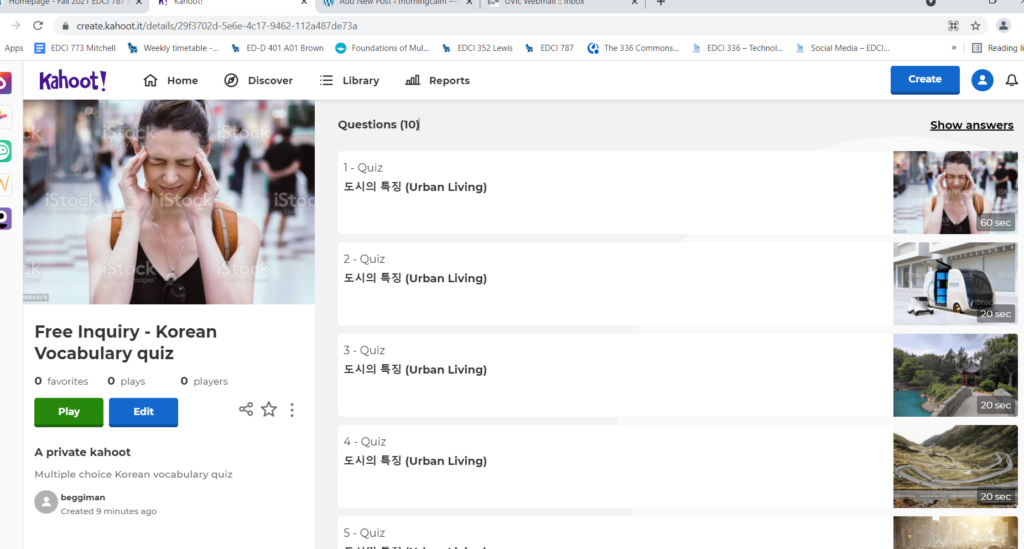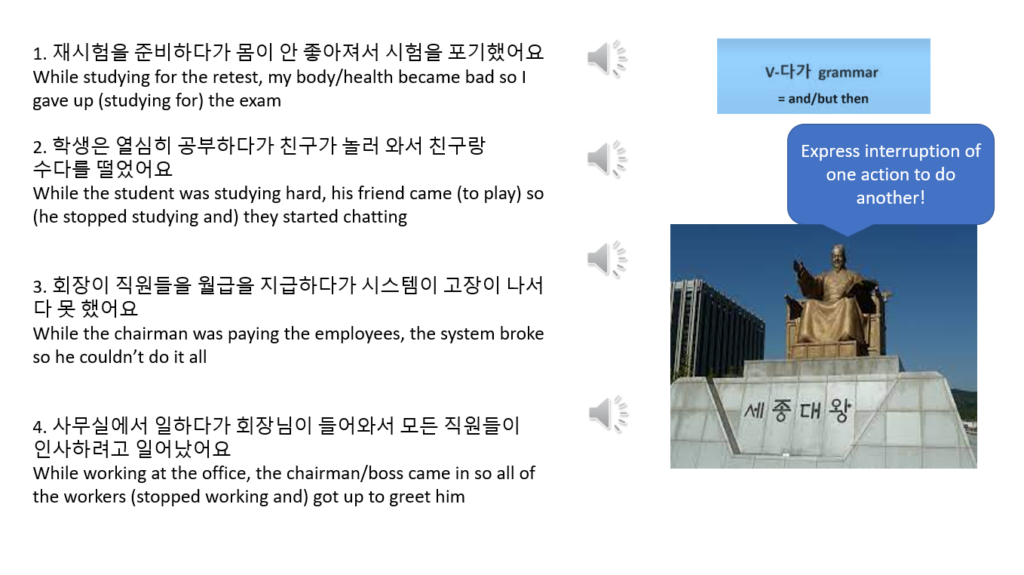Here is a small 10 question Korean Vocabulary Quiz I made on Kahoot! to review vocabulary related to the theme Urban Living which I had been reviewing.

Discovering Korean
This is a category for the EdTech course. Please add this category in addition to the relevant edtech assignment category(ies).
Here is a small 10 question Korean Vocabulary Quiz I made on Kahoot! to review vocabulary related to the theme Urban Living which I had been reviewing.

This week’s lecture nicely demonstrated how technology can complement a lesson. We were introduced to three learning models, namely the SAMR Model for Technology integration, which asks how technology can expand the possibilities regarding learning opportunities; the TPACK Model, a heuristic which shows the how content, pedagogical knowledge and technology can be integrated to make learning more engaging, and Constructive Alignment, which expands on this by incorporating the ‘Big Ideas’ of curriculum with Curricular Competencies (skills) and assessment and how we can find opportunities for technological integration in our syllabi. Lastly, we participated in an EdCamp activity, which I had never experienced and, I found it to be a useful exercise as it is democratic, with topics and content being decided upon by the learners themselves.
The theme of this unit ties in nicely with my group EdTech inquiry project regarding cellphone use and policy in the classroom. At the start of this course, I was adamantly opposed to cell phones in the class. I still advocate a policy of use that centers around teachers justifying the technology and making the determination whether they would enhance learning for a given activity and that a teacher should have a number of pre-planned alternatives so students are not continuously tied in with technology in the room.
I now definitely see how technology, especially in terms of creating visually stimulating materials through graphic curation and organization can increase student engagement. During my Wednesday field trips to a local high school, I have begun to note in parts of a teacher’s lesson where technology would have immediately helped; for example, breaking up the amount stolid text displayed on a whiteboard or PPT, or how an interactive map could replace a 2-D textbook map. Also, it should be encouraged for the creation of multimedia for assessment purposes. Students are noticeably comfortable and accepting of having choice with regards to demonstrating learning and technology will facilitate this. As such, I have begun asking teachers what their end of unit assessment will look like and whether technology can be implemented to make it more appealing to students.

Today, I practiced combining new grammar and taping my voice speaking sentences in Korean. After speaking the sentence, I pasted the audio files to the PowerPoint
Students should have the opportunity to express learning through a variety of media formats. The integration of technology in the classroom allows students to create, share and publish their own content. This is clearly desirable as we as high school educators need to prepare our students to succeed whether in a university or workplace setting. The majority of content is now produced on digital platforms and visually engaging content is essential. For this to occur, educators themselves must possess the ability to create meaningful original media. I think incorporating visually engaging teaching materials would build credibility for the teacher as most students are naturally adept at this using technology outside of the class much more than they do in the classroom.
This week’s class showed me that enhancing the graphic component of a class need not be expensive or time consuming for the teacher. Indeed, programs such as photoshop are available, but I was pleasantly surprised at how I could enhance the visual component of my lessons by simply using PowerPoint, which I have used for a decade in presenting material, but wasn’t aware of the full potential of the program. I have already improved a PowerPoint presentation that I will use in another class. For myself, I believe it is a question of time allocation. We have been presented with numerous programs and apps that can without question improve the quality of instruction for our learners; however, it takes time to become proficient enough to create something of quality in a timely manner; a skill I have not yet acquired. In my situation, I hope I can choose one or two of the available graphic technologies and focus on incorporating these into my practice.
Teachers are being asked to adapt to a stunning transformation in technology where we have little time to understand new technologies before even newer ones emerge. Nevertheless, this creates a opportunity for the teacher to simulate real-world uses of technology in the classroom which will give them practical skills for which they can use in future employment settings. On the other hand, we still have very little idea of the psychological impact of many of these new technologies.
The speaker Jessie Miller put forth a strong argument for arguably maximum inclusion of technology in the classroom, viewing as ‘embracing normalcy’, and that technology works ‘for the purpose facilitating something’. This requires teachers to judiciously determine when tech can enhance a lesson or improve communication of a lesson’s objectives. Multimodality is a reality in the contemporary world of business and employment (i.e. video conferencing, video business proposals, webpages/blogs) and we would be doing our students a disservice if we did not prepare them for this. To the speaker’s credit, he acknowledged that certain times and spaces were unacceptable for devices and advocated a ‘culture of time and place’. I agreed with his assertion that this is an opportunity for student accountability where students can collectively police each other to avoid losses of privileges. We have all experienced feelings of burn out from technology and I would build in ‘zero tech’ days in my classroom to combat this. Moreover, teachers can employ the Premack principle where cell phone use can be used as a reward/break after quality production by students in a lesson. However, the speaker admittedly stated this technology is aimed at kids. I am less comfortable with social media app usage in education. For example, Twitter and its 280-character limit practically lends itself to shallow, superficial analysis and it is unknown whether this format has an effect on the probability of the exchange of vitriolic comments. The pitfalls of this technology for teachers and students alike is great, with potential loss of careers, income and academic suspension one impulsive moment away. Rather, I can see Twitter as a passive resource to view trends in a field among peers.
Grammar Lesson 2: – 고 보니 Expressing Discovery and Result
가: 둘이 아는 사이였어요?
Do you two know each other?
나: 네, 처음에 누군지 몰랐는데 만나고 보니 옛직업 동뇨였어요.
Yeah, At first, I didn’t know who it was, but after meeting him, I realized that we used to work together.
가: 브라이언 씨, 오늘 왜 도시락 안 가지고 갔어요?
Brian, why didn’t you take your lunch today?
나: 미안, 아침에 안 가지고 나갔어요. 학교에 도착하고 보니 도시락이 없더라고요.
Sorry, I left without it. I realized it when I arrived at school.
Meaning in Use
비슷하게 생겨서 제 신발인 줄 알고 신었어요. 그런데 신고 보니 동생의 신발이었어요.
자동차 우화전으로 돌아서 가고 보니 잘못 방향으로 가는것이었요.
This grammar can only be used with verbs. If an adjective or noun / 이다 precedes this grammar, it is grammatically incorrect.
To use adjectives, you must change it to 아/어지다. For example,
전에 축구에 폐력이 좋았는데 나이가 많고 보니 젊은 선수와 축구를 하면 숨 차게 돼네요.
전에 축구에 폐력이 좋았는데 나이가 많아지고 보니 젊은 선수와 축구를 하면 숨 차게 돼네요.
I didn’t notice when I was young, but after having been an expat for so long, I realized how tiring it is.
어렸을때 몰랐는데 오래간 객지생활이고 보니 객지생활 얼마나 힘들다는 것을 새삼 알게 되었어요.
어렸을때 몰랐는데 오래간 객지생활 되고 보니 객지생활 얼마나 힘들다는 것을 새삼 알게 되었어요.
In this stage of my free inquiry, I have decided to translate a long text on Korean public-school education, focusing on vocabulary related to education. I have finished the first paragraph, and I will complete the English translation to this text in the coming week.
한국에서 초등학교의 중학교는 의무교육으로 이루어지기 때문에 일부 특수목적 중하교를 제외하면 대부분 특별한 시험을 보지 않고 입학한다. 고등학교는 의무 교육에 해당되지는 않지만 거의 모든 학생들이 고등학교에 진학하고 있다. 한국에서 고등학교까지 마치는 학생들의 비율은 2014년 기준 98% OECD 국가 평균인 82%보다 높다. 한국의 고등학교 이수 비율이 높은 것은 대학 진학을 희망하는 학생들이 많다는 점과 관련 깊다.
[In Korea, elementary and middle school are compulsory and except for some special purpose middle schools, most students enter without having to take a special entrance exam. High school is not compulsory but almost students progress to high school. The rate of high school graduation in Korea is 98%, higher than the OECD average high school graduation rate of 82%. The high rate of high school completion in Korea is highly connected to desire of many Korean students to enter university.]
대학교에 입학하기 위해서는 일반적으로 대학수능력(수능)을치른다. 수능은 고등학교 졸업 예정자나 졸업자 및 이에 해당하는 학력을 가진 사람이면 누구나 볼수 있고 매년 11월에 실시된다. 수능은 대학에서 공부할 수 있는 능력을 확인하는 시험으로, 대학 진학을 위해 치러야 하는 가장 중요한 시험이라고 할 수 있다. 수능 이외에도 각 대학에서 면접, 논술 등을 거친 후에 대학에 진학하게 된다. 한국의 대학 진학률은 경제협력 개발기구 (OECD) 국가 최고 수준으로 2014에는 약 70%에 달하였다.
In order to enter university, students generally sit the national university entrance exam. The entrance exam is available to high school graduates and those preparing to graduate and is taken annually in November. As a exam which gauges a student’s ability to be able study at the university level, this exam is the most important test that students must take to advance to post-secondary education. Even besides the entrance exam, students must go through interviews and an in-class essay to enter university. Korea’s university entrance rate in 2014 reached 70%, which is the highest rate of post-secondary matriculation among OECD nations.
한국에서 교육은 사회적 지위를 상승시킬 수 있는 중요한 방법 중 하나로 인식된다. 물론 가정 배경 등도 중요하지만, 학력은 취업과 임금에 많은 영향을 주고 있다. 실제로 고등학교 졸업자가 처음 받는 연봉을 100이라고 할 때 중학교 이하 졸업자가 71, 전문대 졸업자가 116, 대학교 이상 졸업자가 161로 집계되어 한국의 학력별 임금차이는 OECD 국가 중에서 가장 큰 것으로 나타났다. 대학을 나와야 사회적인 지위가 올라가고 취업, 결혼 등에 유리하다는 생각 때문에 좋은 대학에 가기 위한 경쟁이 치열하게 벌어지고, 많은 부모들이 비싼 등록금을 감당하면서도 자녀를 기꺼이 대학에 보내려고 한다. 이와 같은 이유로 한국의 대학 진학률은 다른 나라에 비해 매우 높게 나타난다고 할 수 있다.
Education in Korea is acknowledged as one of the important ways to improve social mobility/class. Family background is obviously important, but education has a big effect on employment and income. In fact, if a typical high school graduate receives a salary with a value of 100, those with education levels of middle school or lower is 71, technical college 116, and university graduate and above 161 which reveals that income disparity in Korea per education attainment is the highest in the OECD. Due to the belief that university graduation raise one’s social position and is advantageous for employment and marriage, competition to enter a good university is fierce, and many parents will gladly try to send their children to university even though they have to bear expensive tuition fees. For these reasons, Korea’s university matriculation rate is higher compared to other countries.
가: 이채소는 어떠게 할까요?
What should we do with this vegetables?
나: 먼저 다듬어 가지고 냉장고에 넣어 주세요. 샐러드는 조금 후에 만들거예요.
First tidy them up and put them in the refrigerator. We’ll make the salad a bit later.
가: 양강 씨, 지금 뭐 해요?
Hey. Yang Gang, what are you doing?
나: 빨래를 해 가지고 널고 있어요.
I washed my clothes and now I’m hanging them to dry.
Meaning in Use
돈을 빨리 모아가지고 자동차를 사고 싶어요.
I want to save up a bunch of money and buy a car.
등산갈 때 계가 집에서 감밥을 만들어 가지고 갈게요.
When we go hiking, I’ll make some kimbap to take with us.
할아버지께서 손자들을 불러 가지고 용돈을 주셨어요.
Grandpa called over the grandchildren and gave them all some spending money.
스마트폰을 사고 싶은데 비싸 가지고 못 사겠어요.
I want to buy a smart phone but they are to expensive so I won’t be able to.
지난해에 비해 물가가 많이 올라가지고 생활비가 많이 들어요.
Last year prices have risen a lot so the cost of living has risen as well.
Note: When this grammar is used to express sequence, imperative and propositive forms can be used. In contrast, when this grammar is used to express a reason, the imperative and propositive forms cannot be used.

For my free inquiry project I have decided to document my experience intensively learning Korean again. I lived and worked in Korea from 2005-2012 and developed high proficiency in the language. However, after returning to Canada and subsequently teaching in other countries, my skills have deteriorated. I hope that this process will motivate me to reach my former level and improve even more.
During my free inquiry project, I will be investigating a number of components about learning the Korean language including:

Learning a language is a life-long endeavor and it is my hope that this blog can serve as a way to motivate me to improve and hopefully create interest for other people in learning the Korean language.
What?
The advent of cloud computing, or using the internet to manage and store data on remote network services, has caused an enormous transfer of personal information previously stored on personal computers to both domestic and foreign online service providers, particularly social networking sites. To regulate this, FIPPA (Freedom of Information and Protection of Privacy Act) ensures that information is used and collected in a legal, appropriate way.
So what?
FIPPA affects how a teacher may use personal information about their students. For example, any information which can identify a student must remain confidential and secure. Moreover, it is required that personal information be stored on servers within Canada unless consent is first given by students and parents. Importantly, even though the majority of students are already routinely using a variety of social media and web tools in their private lives including Google Docs, Dropbox and Skype, incorporating that technology into the classroom creates new responsibilities on the part of the instructor. Teachers will therefore have to determine whether the benefits of the technology outweigh the potential inconvenience with regards to an assignment. As students have the right to refuse the disclosure of personal information, teachers will need alternative means of creating an assignment that still meets the instructors intended learning goals without putting them at a disadvantage with to other students because of their refusal. However, many technologies allow the uses of aliases, which would allow teachers to get around difficulties regarding FIPPA compliance. I fear that many teachers, especially ones who are uncomfortable with social media and technology, will avoid the potential headaches involved with sites such as Instagram and opt for safer, traditional means of communication and information delivery.
Now what?
Although the challenges of FIPPA compliance seem daunting, it is encouraging to know that there are many tools which can replace many of the perceived ‘taboo’ apps. For example, students can communicate and share information using Word Press hosting, which is web hosted in Canada. Mattermost, which we use in EDCI 336. can replace non -compliant sites such as Slack and Microsoft Word can be an alternative to Google Docs. With a clear understanding of the value of a given technology and a little flexibility, teachers can safely navigate around FIPPA while still encouraging students to engage in multi-literacies in their learning.
© 2025 morningcalm
Theme by Anders Noren — Up ↑